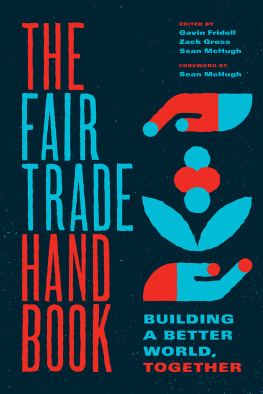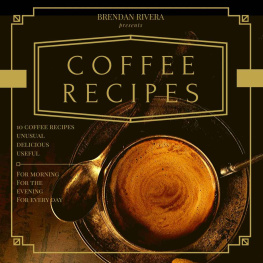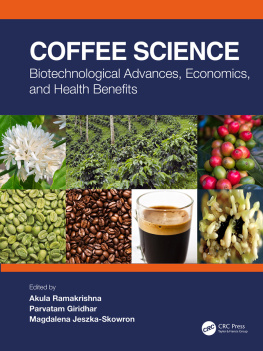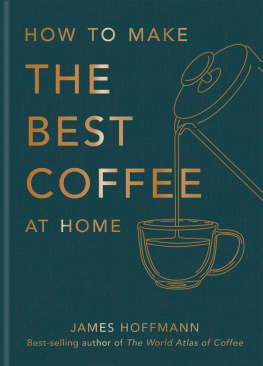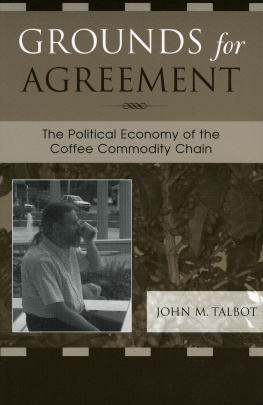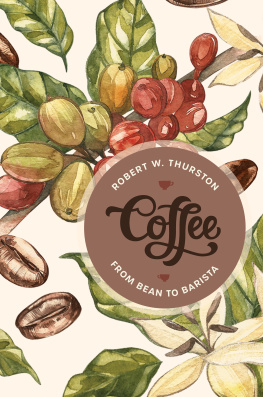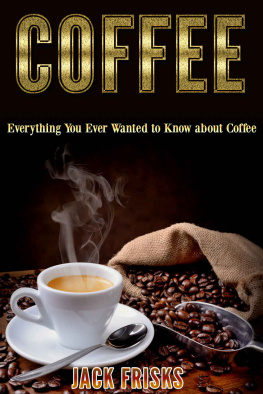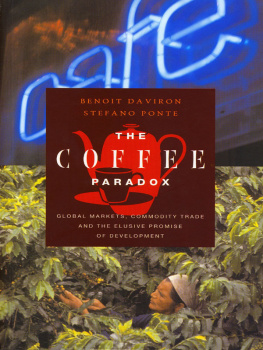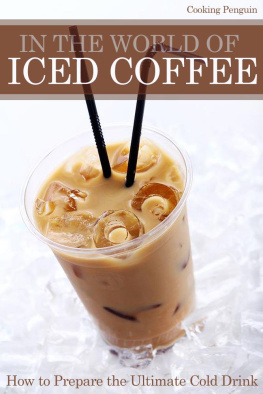Coffee
Resources Series
Gavin Bridge & Philippe Le Billon, Oil
Jennifer Clapp, Food
Peter Dauvergne & Jane Lister, Timber
Elizabeth R. DeSombre & J. Samuel Barkin, Fish
David Lewis Feldman, Water
Derek Hall, Land
Michael Nest, Coltan
Ian Smillie, Diamonds
Copyright Gavin Fridell 2014
The right of Gavin Fridell to be identified as Author of this Work has been asserted in accordance with the UK Copyright, Designs and Patents Act 1988.
First published in 2014 by Polity Press
Polity Press
65 Bridge Street
Cambridge CB2 1UR, UK
Polity Press
350 Main Street
Malden, MA 02148, USA
All rights reserved. Except for the quotation of short passages for the purpose of criticism and review, no part of this publication may be reproduced, stored in a retrieval system, or transmitted, in any form or by any means, electronic, mechanical, photocopying, recording or otherwise, without the prior permission of the publisher.
ISBN-13: 978-0-7456-8590-8
A catalogue record for this book is available from the British Library.
The publisher has used its best endeavours to ensure that the URLs for external websites referred to in this book are correct and active at the time of going to press. However, the publisher has no responsibility for the websites and can make no guarantee that a site will remain live or that the content is or will remain appropriate.
Every effort has been made to trace all copyright holders, but if any have been inadvertently overlooked the publisher will be pleased to include any necessary credits in any subsequent reprint or edition.
For further information on Polity, visit our website: www.politybooks.com
For Sasha, Sebastian, and Kate
Contents
Abbreviations
| ABIC | Brazilian Coffee Roasters Association (Associao Brasileira da Indstria de Caf) |
| ACPC | Association of Coffee-Producing Countries |
| BRICS | Brazil, Russia, India, China, and South Africa (group of states) |
| CAFE | Coffee and Farmer Equity program (Starbucks Coffee Company) |
| CAW 3000 | Canadian Auto Workers, Local 3000 |
| CLAC | Latin American and Caribbean Network of Small Fair Trade Producers (Coordinadora Latinoamericana y del Caribe de Pequeos Productores de Comercio Justo) |
| CSR | corporate social responsibility |
| DWSR | DollarWall Street Regime |
| ECX | Ethiopian Commodity Exchange |
| EIPO | Ethiopian Intellectual Property Office |
| FAO | Food and Agriculture Organization of the United Nations |
| FLO | Fairtrade International |
| FNC | National Federation of Coffee Farmers (Federacin Nacional de Cafeteros), Colombia |
| FOB | free on board |
| Fundeppo | Foundation of Organized Small Producers (Fundacin de Pequeos Productores Organizados) |
| GLOBALG.A.P. | Global Good Agricultural Practices |
| IACA | Inter-American Coffee Agreement |
| IACO | Inter-African Coffee Organization |
| ICA | International Coffee Agreement |
| ICO | International Coffee Organization |
| IISD | International Institute for Trade and Development |
| NCA | National Coffee Association (United States of America) |
| NEZ | New Economic Zone (Vietnam) |
| ODI | Overseas Development Institute |
| PSD | Social Democratic Party (Partido Social Demcrata, Costa Rica) |
| SOE | state-owned enterprise |
| SPS | Small Producers Symbol |
| TNC | transnational corporation |
| UN Comtrade | United Nations Commodity Trade Statistics |
| UNCTAD | United Nations Conference on Trade and Development |
| UNDP | United Nations Development Programme |
| VBARD | Vietnamese Bank of Agriculture and Rural Development |
| VBSP | Vietnam Bank for Social Policy |
| Vinacafe | Vietnam Coffee Corporation |
| WITS | World Integrated Trade Solution |
| WTO | World Trade Organization |
Figures
Acknowledgments
The author would like to thank many colleagues and friends for their advice, inspiration, and support over the years, including Haroon Akram-Lodhi, Greg Albo, Bill Barrett, David Friesen, Ilan Kapoor, David McNally, Viviana Patroni, Darryl Reed, John Talbot, Steven Topik, and Tony Winson. Very special thanks are due Mark Gabbert, Martijn Konings, and Liisa North for our many lengthy chats related to coffee and beyond. An immeasurable debt is owed to all of those who agreed to take time from their busy lives to be interviewed over the years and facilitate my current and earlier research on coffee and commodities in Mexico, the Caribbean, Canada, and Europe. Christina Sayers and Amr El-Alfy were excellent graduate research assistants and Jenny Kaulback and Cassie MacDonald offered invaluable administrative support. Louise Knight and Pascal Porcheron from Polity Press, as well as the anonymous reviewers, provided superb guidance in improving the work and seeing it through. The author is indebted to the International Coffee Organization (ICO) for permitting him the unique opportunity to observe its annual meeting in London, England, in March 2013. Financial and institutional support from the Social Sciences and Humanities Research Council of Canada, the Canada Research Chair program, and Saint Marys University is gratefully acknowledged.
Above all, I would like to thank my family, in particular my espresso club, Sebastian and Sasha, who have infused more energy into the house than any number of coffees could possibly accomplish, and Kate Ervine, as always my unwavering ally in life, without whose guidance and knowledge this book could not have been written. Any errors or omissions, of course, are entirely the authors own.
CHAPTER ONE
The global market and coffee statecraft
Following the global coffee market is a daunting task for any researcher, not least because of the dramatic ups and downs of coffee prices. When I began my graduate studies as a masters student in 1996, coffee prices were in the middle of a five-year recovery after a previous four-year collapse. The coffee composite indicator price, a commonly used estimate that combines different quality beans with different prices, dropped to extreme lows from 1990 to 1993, reaching as low as 54 cents per pound, only to recover starting in 1994, eventually reaching as high as $1.38 per pound. When I started my doctoral work in 1998, the mini-boom had already ended, with prices collapsing once again, this time to the lowest seen in 30 years and by some estimates the lowest prices in real value


